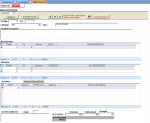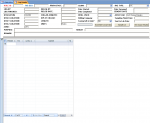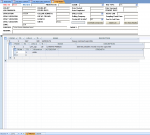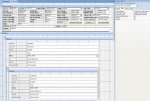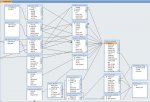Hi All,
Sorry for the long winded post, but hopefully the attached images will help illustrate the problem:
I'm currently developing and adding features to a rather complex database that has scaled well past its original use (isn't that most databases?); a geologic database with hundreds of thousands of records, which are split into many tables with complex relationships.
I've been asked to add a new form for adding in a slightly different type of data, but which does not require addition or restructuring of existing tables.
This form will be used to enter data that has been recorded on paper into the database (see "Paper Form.pdf"). The detailed data entry form ("detailed form.png") is too cumbersome for fast data entry, and so I have started devising a new form ("new form.png"), but have hit a road block integrating all of the tables into one datasheet. The requirements is that the "FROM", "TO", and "HOLE-ID" values would need to be entered once, and then replicated to several tables, while allowing editing across those tables for other fields (see "relationships.png") A query works fine for pulling the data out, but I cannot add new records, which is the goal.
Ideally, I would like to accomplish this without having to code new export queries and macros (a daunting task), and allow the new data to be integrated into the existing data structure.
So what do you think? Do-able? Or messy and cumbersome? Unfortunately I'm on a short deadline, so a dirty hack will have to suffice until I can come up with an elegant solution to the problem, but it would be nice to get off on the correct foot.
Sorry for the long winded post, but hopefully the attached images will help illustrate the problem:
I'm currently developing and adding features to a rather complex database that has scaled well past its original use (isn't that most databases?); a geologic database with hundreds of thousands of records, which are split into many tables with complex relationships.
I've been asked to add a new form for adding in a slightly different type of data, but which does not require addition or restructuring of existing tables.
This form will be used to enter data that has been recorded on paper into the database (see "Paper Form.pdf"). The detailed data entry form ("detailed form.png") is too cumbersome for fast data entry, and so I have started devising a new form ("new form.png"), but have hit a road block integrating all of the tables into one datasheet. The requirements is that the "FROM", "TO", and "HOLE-ID" values would need to be entered once, and then replicated to several tables, while allowing editing across those tables for other fields (see "relationships.png") A query works fine for pulling the data out, but I cannot add new records, which is the goal.
Ideally, I would like to accomplish this without having to code new export queries and macros (a daunting task), and allow the new data to be integrated into the existing data structure.
So what do you think? Do-able? Or messy and cumbersome? Unfortunately I'm on a short deadline, so a dirty hack will have to suffice until I can come up with an elegant solution to the problem, but it would be nice to get off on the correct foot.

